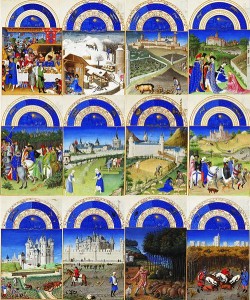The Très Riches Heures du Duc de Berry is a famously known French illuminated manuscript that was painted by the Limbourg brothers. Although the Limbourg brothers were unable to finish the book, this Book of Hours is still considered a valuable piecework. The Très Riches Heures features all the months of the year and depicts the labors during those months for both the duke’s court and servants. Each month piece holds an astrological calendar with the appropriate zodiac sign. The Très Riches Heures is good representation of the seasons as well a demonstration of power and wealth. The Duc de Berry’s Book of Hours was a way to showcase the duke’s his wealth.
Although the Limbourg brothers were unable to finish the Très Riches Heures, I feel like the book should not have been given to another painter to finish. This most likely due to my preference but I would have rather preferred the piece to be unfinished than have something added to the book that was inconsistent with the style. The difference in style can be seen in November and December. The styles for these months are a huge contrast to the orginal Limbourg brother’s style. For instance, in the Limbourg brothers’ paintings, the duke’s castles are always shown but in the last two months they are not. The previous months are lighter while the last two months are darker.This might just be a problem of preference but I believe the Très Riches Heures should have been left unfinished. What do you think?


I also had this thought when we looked at the November/December pages. The difference between the Limbourg brothers’ style and that of John Colombe’s is so strikingly different, I wondered why Colombe wouldn’t have tried to mimic the Limbourg brothers’ style to some degree in order to create more cohesion in the work. The noticeable change in style is interesting in the sense that it makes you think about how unique each painter’s style is, even when they are painting essentially the same subject matter/same piece; however, it definitely caught me off guard in a way that instinctively made me wish that the Limbourg brothers could have finished what they started. I wonder how the patron–the Duc de Berry–felt about it.
While the style may be different, I actually like that someone tried to finish it. The contrast between the styles is obvious and thus interesting to examine.
I know this is an unpopular opinion, but I believe despite the obviously impressive feat by the Limbourg brothers, Colombe’s painting is actually a more interesting visual. It is for these reasons, despite nodding toward movement in the composition, the actual figures appear stiff and statuesque. Perhaps a result of the stepping away from the “international S”motif of human rendering in flatter representations, the eye has no clear path of rhythm to follow. Similarly, the rather wonky perspective for depth adds a sharp reminder that these are two dimensional rendering. However, I believe Colombe was able to develop a more clear sense of atmosphere, season, and more importantly of time; we look upon his work as if we caught a frozen moment and as if this moment was getting ready to breathe life once more.
Araseli,
Firstly, wonderful article for I agree with you wholeheartedly that the Très Riches Heures should have been left unfinished. However, its identity as a French Gothic manuscript renders it victim to Western aesthetics, a broad ideology that has always privileged perfection over imperfection. It is ironic then that we see so much imperfection then through the change of style in the last two months.
I say all this because I feel if this manuscript were to be made within the philosophies of Eastern aesthetics, it would be left unfinished for it would symbolize what is impermanent and incomplete, what is inherently human, thus, reinforcing ‘that things don’t last forever’.
Naturally then, the Très Riches Heures’ identity as a religious manuscript almost forces it to convey the ‘perfection’ of God. An unfinished manuscript, in the Western tradition, would be to say God is not perfect.